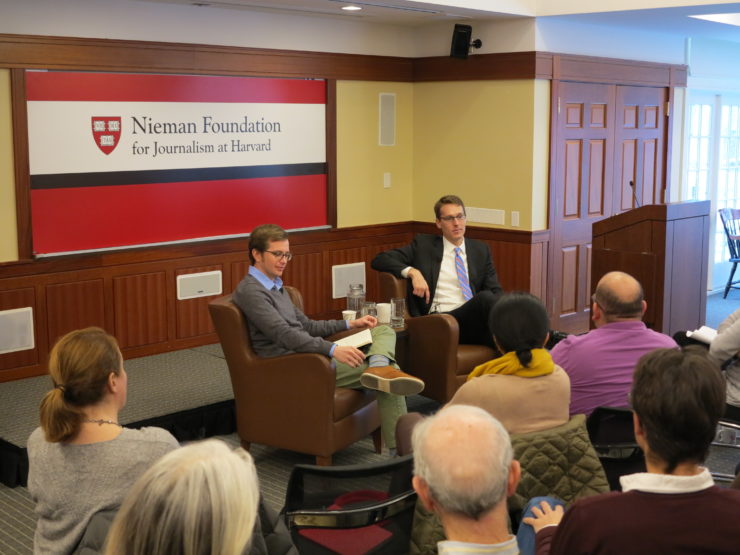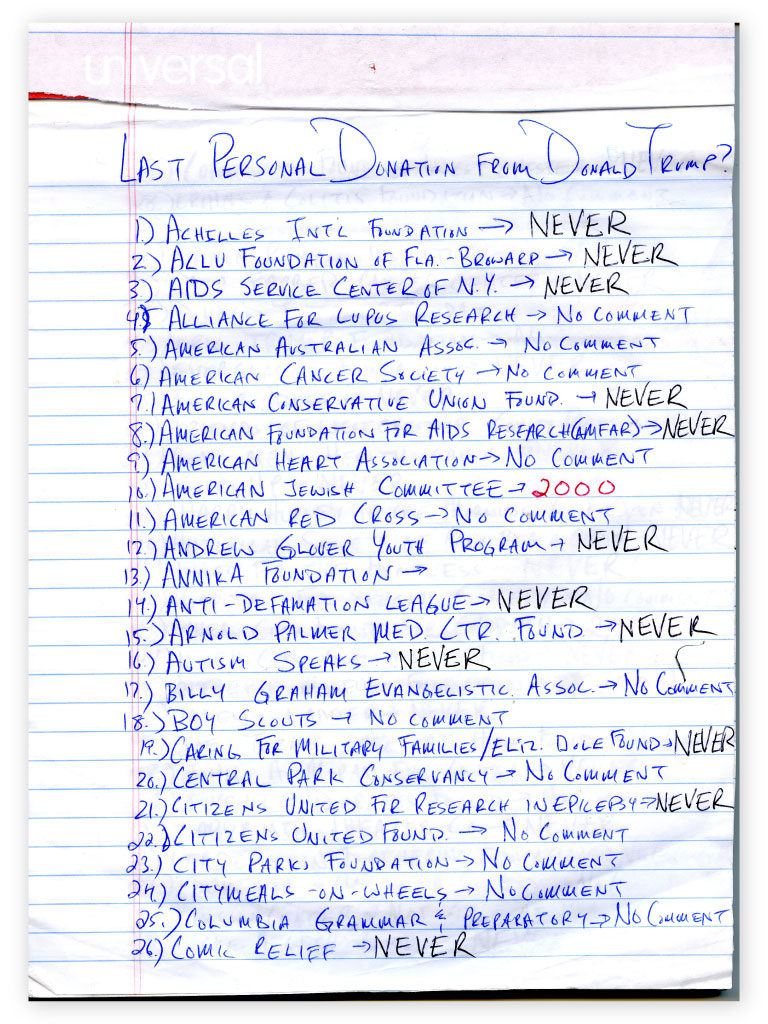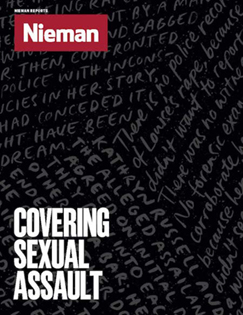
David Fahrenthold tapped into the power of social media when researching Trump's charitable giving, enlisting his followers for help
Few reporters covering the 2016 presidential election had as many memorable scoops and were as successful at using Twitter to crowdsource research as David Fahrenthold. A reporter for The Washington Post since 2000, he is best known for his exhaustive dive into the financial dealings of then candidate Donald Trump’s charitable organization as well as his acquisition of the “Access Hollywood” videotape in which the candidate bragged about sexually assaulting women.
Frustrated in his efforts to find out about charitable donations Trump said he had made, Fahrenthold turned to Twitter, where he now has more than 300,000 followers. The pictures he posted of handwritten lists from his reporter’s notebook told a stingy story, and his followers offered reporting help and tips. One told him about a charity event at which Trump claimed a seat on stage that had been set aside for a developer who had actually given a donation.
In January, he was named a contributor to CNN, where he will appear regularly in addition to his role with the newspaper. During a recent talk at the Nieman Foundation, he discussed his approach to reporting and how journalists need to reorient themselves to cover a president like no other. Edited excerpts:
On covering Trump’s charitable foundation
In the middle of a [campaign] rally in Waterloo, Iowa, Donald Trump gives to a veterans group this big golf tournament-sized check for $100,000 from the Donald J. Trump Foundation. I didn’t know much about charity then but I know that’s illegal. You can’t use your charity to boost your political campaign. He had said a few days earlier that he’d raised $6 million for veterans. But the big checks only amounted to about a million dollars. Was it illegal that he was doing this? Where’s the rest of the money? So I thought, ‘I’ll spend a day and figure out where the rest of the money went.’ And it wasn’t a day, it wasn’t a week, it wasn’t two weeks. Every time I called the Trump people or I called the organizations that were supposed to have been getting the money I couldn’t find the answers. In the process I learned more about how charity law works. So finally Trump’s campaign manager called me and said, ‘just know he gave a million dollars away.’ I spent a couple days checking on that. And that was a lie. We caught Trump trying to claim he had given a million dollars when he hadn’t. After that all blew over, we thought, ‘well let’s go look at Trump’s charitable giving.’ If he’s willing to basically stiff veterans in the middle of a Republican presidential campaign, what’s he been willing to do before?
One of the things that was amazing about this story was how my conception of what I was looking for at the beginning was at least partially wrong. I started out thinking I was looking for evidence that Trump gave money out of his own pocket. It turned out that the Trump Foundation was a story in itself and I didn’t realize that until I started calling charities. One example was the Susan G. Komen Foundation breast cancer charity which got a donation of $12,000—sort of an odd number, so I called them. It was to buy a Tim Tebow helmet at a charity auction. This gives you a sense of Trump as a businessman. It’s important to know that, at literally the hour of the auction, Tim Tebow was playing the New England Patriots and being destroyed. This was the end of Tebow’s career. Trump paid for the helmet with money from the Trump Foundation.
If you buy something from a charity for your own use, you have to use your own money. If the charity buys the thing, it has to be used for charitable purposes. So unless he gave it to a street urchin or he used the helmet for something charitable, that was an illegal gift. This took something that was sort of abstract, like Trump breaking charity laws, and put in there a tangible object that symbolized the story.

Pages from Fahrenthold's notebook documenting Trump's charitable giving—or lack of it
On Twitter-aided reporting
Trump has said over the years that he’d given millions and millions of dollars to charity and so we’re looking for evidence. You can call every charity in America but that would take too long. And Trump himself wouldn’t cooperate. So how do I look for evidence and how do I show people—including Trump supporters—how hard I am looking for it? After I called about 100 charities that might have been likely recipients of donations from Trump, I thought,‘I’m going to go on Twitter to show people how hard I’m trying and also to solicit advice.’ One of the things I learned was that I didn’t appreciate how much other people know that you can tap into with social media. I got a lot of really good faith suggestions from people.
The smallest donation the Trump foundation ever made was $7 to the Boy Scouts in 1989. I put it on Twitter to amuse people. People pick this up and start chewing it over. First the hive mind thinks that maybe this is for popcorn sold by the Boy Scouts. Some people out there on Twitter who were Boy Scouts in the late ’80s remember selling popcorn and they remember the name of the popcorn company, but $5 was the most expensive popcorn you could buy from the Boy Scouts in 1989. People start pulling up archives of newspapers from back in the ’80s. They figure out that in 1989 it cost $7 to register a boy for the Boy Scouts. That was the year that Don Jr. became old enough to join. He was 11. I don’t know for sure that’s what Trump did because I don’t have the receipt, but it appears that Trump, a millionaire at the time, used charity money to sign up his son for the Boy Scouts. That’s something I just never would have figured out on my own.
On new directions for reporting
I hope we cover state legislatures and state races more. I think we missed telling the story of the demise of the Democrats as a party. They were withering as a party in the Obama years. We wrote about it a little bit but we didn’t explain the mechanics of what were they doing wrong. Now the Democrats have lost power in Washington and they also are way out of power in many states. That part of politics gets so much less attention than the presidential race, which we cover like mad for two-plus years and it’s only part of the picture.
On covering Trump
We haven’t really figured out all the different inputs, all the things to be watching. Covering conflicts of interest was never anything that we ever had to cover a president doing before. The places where news could come from are changing, like yesterday there was a lawsuit connected to Melania Trump planning on launching a line of fragrances based on her status as first lady. I didn’t know to look for that until somebody else got it and beat me on it. There’s also looking at the Labor Department statistics to see if the Trump winery is applying for workers from overseas, given the fact that Trump is trying to clamp down on immigration. Before this administration there had been a centralization of the people who might provide new information. There were a few people who had power. We got spoiled by the fact that they were not that many places where news could arrive from. And now we’re having to reorient ourselves to watch a bunch of different things and to synthesize a bunch of different stuff that was not part of political reporting before.
On reaching Trump supporters
It’s not our job to convince his supporters to give up on Trump. To me the question is, what’s the best way to keep their attention, to keep them as readers? And I think one way is to not be hysterical. Just tell people what Trump is doing and what are the results of what Trump’s doing relative to the goals that he has set out. A side issue is how do we show what we know, how do we show how we arrived at the things that we know.
I think it’s important to continue writing about folks who voted for Trump, what they care about and are there things changing concretely in their lives in ways they like. We need to understand the questions that they’re asking and the metrics that they are placing on Trump’s administration. I think there’s a lot of unconscious bias especially among people in Washington. We’re evaluating him based on the things that people around us care about. It’s important to understand the ways that people will judge him. Like with the small number of jobs he saved at the Carrier factory. Other jobs around there were going away. But it was him showing that he cared about those people. And I think that’s an important metric to watch. Does he do that more often? How many jobs does he actually save? Does he create more of a mess by doing that? If that’s the metric you care about— him creating jobs or saving jobs—is he doing it right? I try to do my job well and to do it without bringing preconceptions to it about what a Trump success is.


